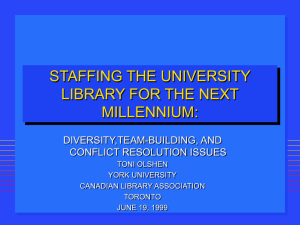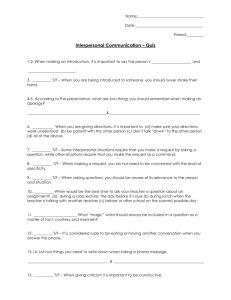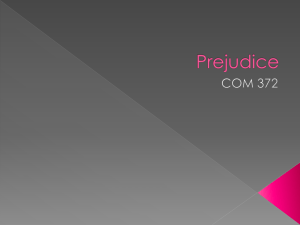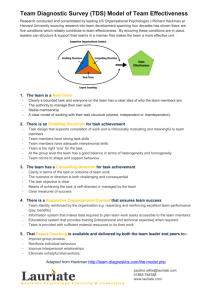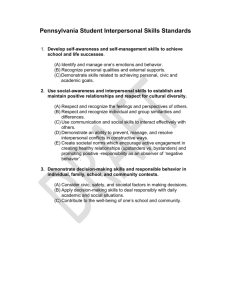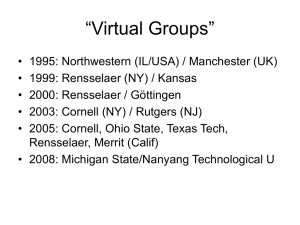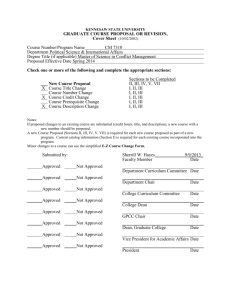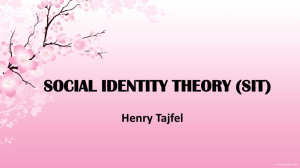Definition of Team - University of Arizona Libraries
advertisement
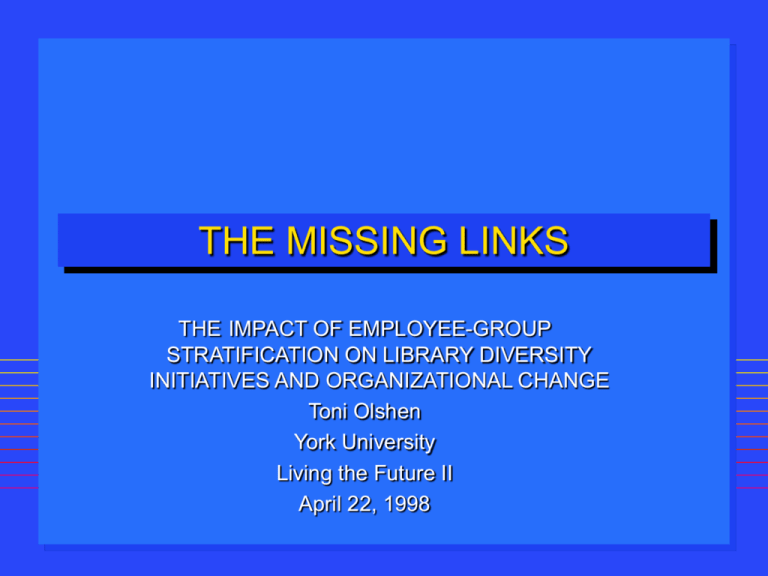
THE MISSING LINKS THE IMPACT OF EMPLOYEE-GROUP STRATIFICATION ON LIBRARY DIVERSITY INITIATIVES AND ORGANIZATIONAL CHANGE Toni Olshen York University Living the Future II April 22, 1998 PROFILE OF YORK UNIVERSITY 33,990 undergraduate students -2,325 on campus - 7,975 part-time 3,910 graduate students - 1,325 on campus 1,125 faculty members 6,025 other staff YORK UNIVERSITY LIBRARY STAFF - 1997 Librarians - York University Faculty Association -36 Professional and Managerial - 14 Support Staff - York University Staff Association -125 Student Assistants - 197 = 49 FTE - York University Staff Association II and III Total staff = 224 DIVERSITY Diversity initiatives in academic libraries focus on the development of workplace climates that value and welcome differences. Diversity implies including on teams not only those individuals who differ with respect to characteristics such as age, gender, race and ethnicity but also those who differ in amount of experience, sets of skills or occupations, and hierarchical levels. DEFINITION OF A TEAM A team is a small group of people with complementary skills committed to a common purpose and set of specific performance goals. Katzenbach, Jon. The Wisdom of Teams, p.21 KEY POINTS ABOUT TEAMS • • • • • • • True teams are very different from other kinds of work groups. Team effectiveness is measured by useful output, not good feelings Effective teams are skilled at dealing with internal problems such as conflict Diversity and complementarity of style and expertise make teams stronger Effective team leaders practice facilitational leadership rather than controlling leadership Teams benefit from the output of all members Mutual respect and mutual accountability are the cornerstones of team effectiveness. Soete, George. “Reorganizing for a Changing Information World.”p.112 QUESTIONS TO ASK TO COUNTER STRATIFICATION Do we have important skills that are not captured by our formal roles and responsibilities? Can we better utilize the basic skills and experiences of our group by working together beyond as well as within our formal, functional responsibilities? Could some of us build skills in other areas, and thereby help strengthen the overall capabilities of the group? Can we break up hierarchical patterns by assigning work tasks based on skills rather than position? Can we assign leadership roles to someone other than a manager? Katzenbach, Jon. The Wisdom of Teams, p. 237. TEAM NORMS All ideas are given a fair hearing Everyone will have an opportunity to contribute information and opinions Open and honest opinions are welcome Members are expected to actively listen to one another Rank does not have its privileges Parker, Glenn. Cross-Functional Teams. p.116 INTERNAL ISSUES Conflict resolution, the ability of team to discuss and resolve differences Open communication and trust, the degree to which team members feel free to express their views Parker , Glenn. Cross-Functional Teams, p. 160 CONFLICT As the traditional hierarchical organization gives way to group-based structures, conflicts on teams will become more prevalent. If we define conflict as simply differences of opinion, this is exactly what we want to happen. Group Differentiation Criteria for differentiation among groups Equally valued roles that are similar, qualitatively distinct, or interdependent Mode of conflict or prevention Intergroup concerns fostered through goal structure, division of labor, or mutual role indispensability Conditions for failure of conflict resolution Groups are not equally valued for their intergroup roles Thalhofer, Nancy. “Intergroup Differentiation and Reduction of Intragroup Conflict”,p.31 TYPES OF TEAM CONFLICT Relationship conflict exists when there are interpersonal incompatibilities among group members which typically includes tension, animosity, and annoyance. Task conflict exists when there are disagreements among group members about the content of the tasks being performed, including differences in viewpoints, ideas and opinions. Jehn,Karen. “A Multimethod Examination of the Benefits and Detriments of Intrgroup Conflict”, p. 258. TEAM CONFLICT INTERPERSONAL CONFLICT TASK-BASED CONFLICT • • ROUTINE NON-ROUTINE INTERPERSONAL TEAM CONFLICT The limited cognitive processing resulting from relationship conflict reduces the ability group members to assess new information provided by other members The interpersonal conflict makes members less receptive to the ideas of other group members The time and energy that should be devoted to working on the task is used to discuss, resolve, or ignore conflicts Jehn, Karen.“A Multimethod Examination of the Benefits and Detriments of Intrgroup Conflict”, p. 258 BENEFITS OF CONFLICT FOR NON-ROUTINE TASKS • • • • • • Diverse ideas of group members introduce superior alternatives Critical evaluation facilitated by task conflict Decreases groupthink phenomenon by increasing consideration of alternatives Encourages creativity by focussing on innovative ideas rather than consensus Increases the understanding of the task by identifying and discussing diverse perspectives Allows for a more thorough evaluation of criteria needed for sound decision-making BENEFICIAL CONFLICT Task type Task interdependence Group norms DEALING WITH TEAM CONFLICT Team training must include sessions on conflict resolution Top management as well as functional department managers must be helped to form realistic expectations of the potential outcome of crossfunctional teams In some cases, teams may need expert help in facilitating team processes Parker , Glenn. Cross-Functional Teams, p. 163. LESSONS LEARNED Team structures have the potential to mitigate the negative impacts of group stratification They draw out the benefit of skills available in all our staff to achieve better outcomes Valuing and respecting the contributions of all staff, regardless of their employee group, enhances the quality of our decision-making Conflicts are what we want to push us to creative solutions. It is how we handle these conflicts that is the test. It is vital that in the training and preparation for teamwork that we include conflict resolution skills Establish team norms that make conflict work for the organization. Different types of tasks produce different types of conflict Since we cannot make conflict go away, we should work with it to maximize its benefits.
